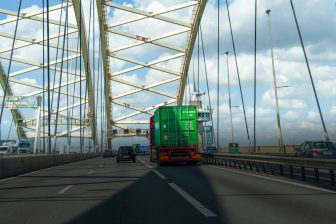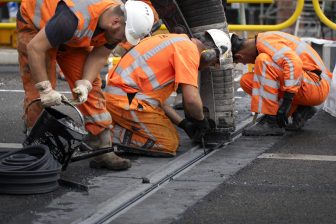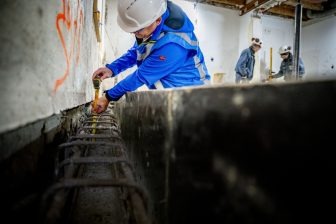Toespraak van de Prins van Oranje tijdens Symposium Smart and Sustainable Built Environments 2009
Toespraak van de Prins van Oranje tijdens het Symposium Smart and Sustainable Built Environments 2009 (SASBE2009) te Delft, 16 juni 2009
De toespraak is uitgesproken in het Engels.
Distinguished guests, ladies and gentlemen,
Let me start by thanking Ken Yeang and Dirk Sijmons for sharing their expertise and views with us – a real learning experience. It is always a pleasure to listen to people who can vividly communicate their knowledge. Theirs is a hard act to follow, so please bear with me.
When we talk about a smart and sustainable environment we actually mean how smart we can be, and how sustainably we can design and build. The natural environment has a way of taking care of itself. So how smart do we have to be, and to what lengths must we go to adapt to climate change and to the fact that our resources are limited? These are the issues at the heart of today’s discussions.
Water, ladies and gentlemen, is the source of all life. It shapes our lives. We live on a blue planet, with a water-to-land ratio of 70 to 30. To say we have water in abundance is almost an understatement.
The problem, however, is that this abundance is not evenly distributed. Some parts of the world suffer from years of drought, while others are hit by flooding.
On 25 May, Bangladesh and the eastern Indian state of West Bengal were hit by cyclone Aila. The cyclone caused widespread flooding and claimed many lives. Many more people were made homeless, and local industries and economies were destroyed. Shortly before Aila struck, the Australian states of Queensland and New South Wales also faced widespread flooding. Yet at the same time, farmers in southern Australia are still praying for rain.
Located on a delta, the Netherlands has also had its fair share of flooding. Throughout the centuries, we have built barriers and other systems to keep our feet dry. And, as you all know, we have reclaimed land. We have to cope with water from three sources: precipitation, from above, river water from the east, and the saline waters to the west. So we like to think we know a bit about water management. We Dutch have become accustomed to the notion that our most densely populated areas are below sea level. These are also the most productive areas economically, where we earn 65 per cent of our GNP. Without dams, dikes and dunes, two-thirds of the Netherlands would be flooded regularly.
Water does not merely influence spatial planning and development in the Netherlands. It is the decisive factor.
We are building ever stronger dikes to prevent flooding. We are reserving space to store surplus water from our rivers. We are also exploring opportunities to build floating homes. After centuries of restraining the water with dikes, polders and huge infrastructural projects, the time has now come to adapt.
The time has now come to live with water, not fight it.
Spatial planning and water management are inextricably linked. That doesn’t only apply at central government level, but also at local and regional level: at the level of the provinces, municipalities and water authorities. Because this is where our policy is implemented. And this is why we are drafting regional water management strategies.
But besides governmental structures, we also need science. Good policy is based on facts. We need information about the condition of our dikes, our freshwater stocks, and the rate at which the sea level is rising. We need to continue examining our policy in the light of scientific developments. That is why I am pleased to be here today to make my contribution to Smart and Sustainable Built Environment 2009. SASBE shows us that there are many solutions to climate change and to the problems we face as fossil fuels become exhausted.
Some of these solutions are well known to us. We now have many years’ experience of making our buildings energy efficient. And in many locations in our urban areas, there are measures we can take to prevent flooding after heavy rainfall – increasing the capacity of sewers, and building temporary water storage facilities, for example. SASBE has also generated a number of solutions, such as Eindhoven University’s membrane roof. The main challenge is to apply these solutions so that they contribute to both climate mitigation and climate adaptation, and ensure a maximum contribution at every level.
First – and inevitably in the Netherlands – at the level of the Delta. Last year, the Dutch Delta Commission advised the Dutch government on ways of protecting the country against flooding in the wake of climate change. Based on a worst-case scenario, the Commission issued twelve recommendations.
These recommendations envisage interventions along the entire coast, which protects half of the Netherlands from flooding, and along major European rivers with estuaries in the Netherlands. The Delta Commission also issued recommendations about the choice of location for new building projects. No buildings should be located where they might form an obstacle to the drainage capacity of rivers or to future plans to raise the levels of inland lakes. And buildings may only be planned at physically unfavourable locations – for instance in very low-lying polders – after a social cost-benefit analysis which takes on board current and future costs.
This April, the Environmental Assessment Agency confirmed that freshwater supplies and long-term protection against flooding were indeed the two most important challenges for the spatial planning of the Netherlands in the face of climate change. The Agency added a number of other issues: for instance, the need to climate-proof nature and urban areas and make transport and energy networks less vulnerable.
Interventions are also needed at town or city level, the level with which SASBE participants probably have the greatest affinity. The vulnerability of urban areas to climate change is closely linked to flooding after heavy rainfall and damage to the foundations of buildings after long periods of drought. Given their high population densities, urban areas are also at risk from allergies, infectious diseases and heat stress in extremely hot summers. Up to now these problems have had a limited impact, but we are still unsure of the effects in a worst-case scenario.
There are many opportunities for creating synergies in urban areas, as this is where challenges relating to climate-proofing, climate mitigation and improving the quality of life come together. One of the most interesting is to create win-win situations using planning measures for open water and green spaces that increase water storage capacity, limit heat stress and improve the quality of the living environment. I understand that one of the papers to be presented today identifies opportunities for using open stretches of water to cool buildings.
This brings us to neighbourhood level, where the restructuring of existing urban areas and the development of new ones also presents opportunities for combining adaptation measures with energy conservation and sustainable energy.
Designs for energy-efficient buildings may, for example, include green roofs to prevent heat stress. They may also harvest surplus heat, and use innovative sources of energy to provide extra air-conditioning. Exchange and storage of heat and cold present opportunities for sustainable air-conditioning at neighbourhood level, while reducing energy consumption in the winter.
Unlike rural areas, urban areas are not very flexible as regards spatial development and planning, and reorganisation is often a costly business.
In the next thirty years, nearly a million new homes will need to be built in the Netherlands, and other European countries face similar challenges. But existing housing stocks – in the Netherlands we are talking about six and a half million homes – will also need climate-proofing over the next fifty years. This will call for a similar operation to the housing insulation campaign of the 1970s and 1980s.
And this brings me to the fourth and final level: the level of the building. I will not list all the solutions you have come up with. Suffice it to say that you have identified opportunities for interventions in design, construction, transformation and flexibility.
A wealth of solutions, in other words. Now they have to be applied.
Besides the scientists, the business community is also making a contribution. Companies do much of the actual work. Engineers tell us what is needed, contractors implement projects, and developers are involved in spatial planning.
The main lesson we have learnt from our centuries-old battle with water is that we cannot afford to work in isolation. In a changing world, and with a changing climate, we will only succeed in living with water and conserving energy by bridging levels of government, breaking down the walls between politics, science and industry, and transcending the boundaries between our countries and the oceans that separate our continents.
International forums present opportunities for us to find partners and to prepare together for climate change. Let us build lasting relationships, so that we can take up the challenge of climate change, share the burden, and thus lighten the load.
United we stand, divided we fall. That is certainly the case when it comes to climate change. Let us think, work and build as one. We have no alternative.
Thank you.
U las zojuist één van de gratis premium artikelen
Onbeperkt lezen? Profiteer nu van de introductieaanbieding voor € 10,- per maand.
Bent u al abonnee?



